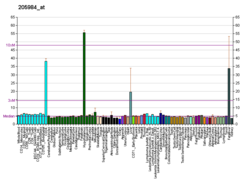CRHBP
| CRHBP | |||||||||||||||||||||||||||||||||||||||||||||||||||
|---|---|---|---|---|---|---|---|---|---|---|---|---|---|---|---|---|---|---|---|---|---|---|---|---|---|---|---|---|---|---|---|---|---|---|---|---|---|---|---|---|---|---|---|---|---|---|---|---|---|---|---|
| Identifiers | |||||||||||||||||||||||||||||||||||||||||||||||||||
| Aliases | CRHBP, CRF-BP, CRFBP, corticotropin releasing hormone binding protein | ||||||||||||||||||||||||||||||||||||||||||||||||||
| External IDs | OMIM: 122559; MGI: 88497; HomoloGene: 1418; GeneCards: CRHBP; OMA:CRHBP - orthologs | ||||||||||||||||||||||||||||||||||||||||||||||||||
| |||||||||||||||||||||||||||||||||||||||||||||||||||
| |||||||||||||||||||||||||||||||||||||||||||||||||||
| |||||||||||||||||||||||||||||||||||||||||||||||||||
| |||||||||||||||||||||||||||||||||||||||||||||||||||
| |||||||||||||||||||||||||||||||||||||||||||||||||||
| Wikidata | |||||||||||||||||||||||||||||||||||||||||||||||||||
| |||||||||||||||||||||||||||||||||||||||||||||||||||
Corticotropin-releasing factor-binding protein is a protein that in humans is encoded by the CRHBP gene.[5][6] It belongs to corticotropin-releasing hormone binding protein family.
Corticotropin-releasing hormone is a potent stimulator of synthesis and secretion of preopiomelanocortin-derived peptides. Although CRH concentrations in the human peripheral circulation are normally low, they increase throughout pregnancy and fall rapidly after parturition. Maternal plasma CRH probably originates from the placenta. Human plasma contains a CRH-binding protein which inactivates CRH and which may prevent inappropriate pituitary-adrenal stimulation in pregnancy.[6]
References
- ^ a b c GRCh38: Ensembl release 89: ENSG00000145708 – Ensembl, May 2017
- ^ a b c GRCm38: Ensembl release 89: ENSMUSG00000021680 – Ensembl, May 2017
- ^ "Human PubMed Reference:". National Center for Biotechnology Information, U.S. National Library of Medicine.
- ^ "Mouse PubMed Reference:". National Center for Biotechnology Information, U.S. National Library of Medicine.
- ^ Behan DP, Potter E, Lewis KA, Jenkins NA, Copeland N, Lowry PJ, Vale WW (Jun 1993). "Cloning and structure of the human corticotrophin releasing factor-binding protein gene (CRHBP)". Genomics. 16 (1): 63–8. doi:10.1006/geno.1993.1141. PMID 8198617.
- ^ a b "Entrez Gene: CRHBP corticotropin releasing hormone binding protein".
External links
- Human CRHBP genome location and CRHBP gene details page in the UCSC Genome Browser.
Further reading
- Behan DP, De Souza EB, Lowry PJ, et al. (1996). "Corticotropin releasing factor (CRF) binding protein: a novel regulator of CRF and related peptides". Frontiers in Neuroendocrinology. 16 (4): 362–82. doi:10.1006/frne.1995.1013. PMID 8557170. S2CID 1704154.
- Westphal NJ, Seasholtz AF (2006). "CRH-BP: the regulation and function of a phylogenetically conserved binding protein". Front. Biosci. 11: 1878–91. doi:10.2741/1931. PMID 16368564.
- Potter E, Behan DP, Fischer WH, et al. (1991). "Cloning and characterization of the cDNAs for human and rat corticotropin releasing factor-binding proteins". Nature. 349 (6308): 423–6. Bibcode:1991Natur.349..423P. doi:10.1038/349423a0. PMID 1846945. S2CID 4271589.
- Behan DP, Linton EA, Lowry PJ (1989). "Isolation of the human plasma corticotrophin-releasing factor-binding protein". J. Endocrinol. 122 (1): 23–31. doi:10.1677/joe.0.1220023. PMID 2549150.
- Behan DP, Heinrichs SC, Troncoso JC, et al. (1995). "Displacement of corticotropin releasing factor from its binding protein as a possible treatment for Alzheimer's disease". Nature. 378 (6554): 284–7. Bibcode:1995Natur.378..284B. doi:10.1038/378284a0. PMID 7477348. S2CID 4305815.
- Vamvakopoulos NC, Sioutopoulou TO, Durkin SA, et al. (1995). "Mapping the human corticotropin releasing hormone binding protein gene (CRHBP) to the long arm of chromosome 5 (5q11.2-q13.3)". Genomics. 25 (1): 325–7. doi:10.1016/0888-7543(95)80151-B. PMID 7774945.
- Maruyama K, Sugano S (1994). "Oligo-capping: a simple method to replace the cap structure of eukaryotic mRNAs with oligoribonucleotides". Gene. 138 (1–2): 171–4. doi:10.1016/0378-1119(94)90802-8. PMID 8125298.
- Fischer WH, Behan DP, Park M, et al. (1994). "Assignment of disulfide bonds in corticotropin-releasing factor-binding protein". J. Biol. Chem. 269 (6): 4313–6. doi:10.1016/S0021-9258(17)41780-7. PMID 8307998.
- Donaldson CJ, Sutton SW, Perrin MH, et al. (1996). "Cloning and characterization of human urocortin". Endocrinology. 137 (5): 2167–70. doi:10.1210/endo.137.5.8612563. PMID 8612563.
- Asakura H, Zwain IH, Yen SS (1997). "Expression of genes encoding corticotropin-releasing factor (CRF), type 1 CRF receptor, and CRF-binding protein and localization of the gene products in the human ovary". J. Clin. Endocrinol. Metab. 82 (8): 2720–5. doi:10.1210/jcem.82.8.4119. PMID 9253360.
- Suzuki Y, Yoshitomo-Nakagawa K, Maruyama K, et al. (1997). "Construction and characterization of a full length-enriched and a 5'-end-enriched cDNA library". Gene. 200 (1–2): 149–56. doi:10.1016/S0378-1119(97)00411-3. PMID 9373149.
- Strausberg RL, Feingold EA, Grouse LH, et al. (2003). "Generation and initial analysis of more than 15,000 full-length human and mouse cDNA sequences". Proc. Natl. Acad. Sci. U.S.A. 99 (26): 16899–903. Bibcode:2002PNAS...9916899M. doi:10.1073/pnas.242603899. PMC 139241. PMID 12477932.
- Wetzka B, Sehringer B, Schäfer WR, et al. (2004). "Expression patterns of CRH, CRH receptors, and CRH binding protein in human gestational tissue at term". Exp. Clin. Endocrinol. Diabetes. 111 (3): 154–61. doi:10.1055/s-2003-39778. PMID 12784189.
- Claes S, Villafuerte S, Forsgren T, et al. (2003). "The corticotropin-releasing hormone binding protein is associated with major depression in a population from Northern Sweden". Biol. Psychiatry. 54 (9): 867–72. doi:10.1016/S0006-3223(03)00425-6. PMID 14573312. S2CID 21112652.
- Sehringer B, Zahradnik HP, Simon M, et al. (2005). "mRNA expression profiles for corticotrophin-releasing hormone, urocortin, CRH-binding protein and CRH receptors in human term gestational tissues determined by real-time quantitative RT-PCR". J. Mol. Endocrinol. 32 (2): 339–48. doi:10.1677/jme.0.0320339. PMID 15072543.
- Gerhard DS, Wagner L, Feingold EA, et al. (2004). "The status, quality, and expansion of the NIH full-length cDNA project: the Mammalian Gene Collection (MGC)". Genome Res. 14 (10B): 2121–7. doi:10.1101/gr.2596504. PMC 528928. PMID 15489334.
- Herringa RJ, Roseboom PH, Kalin NH (2006). "Decreased amygdala CRF-binding protein mRNA in post-mortem tissue from male but not female bipolar and schizophrenic subjects". Neuropsychopharmacology. 31 (8): 1822–31. doi:10.1038/sj.npp.1301038. PMID 16482088.
- v
- t
- e


















